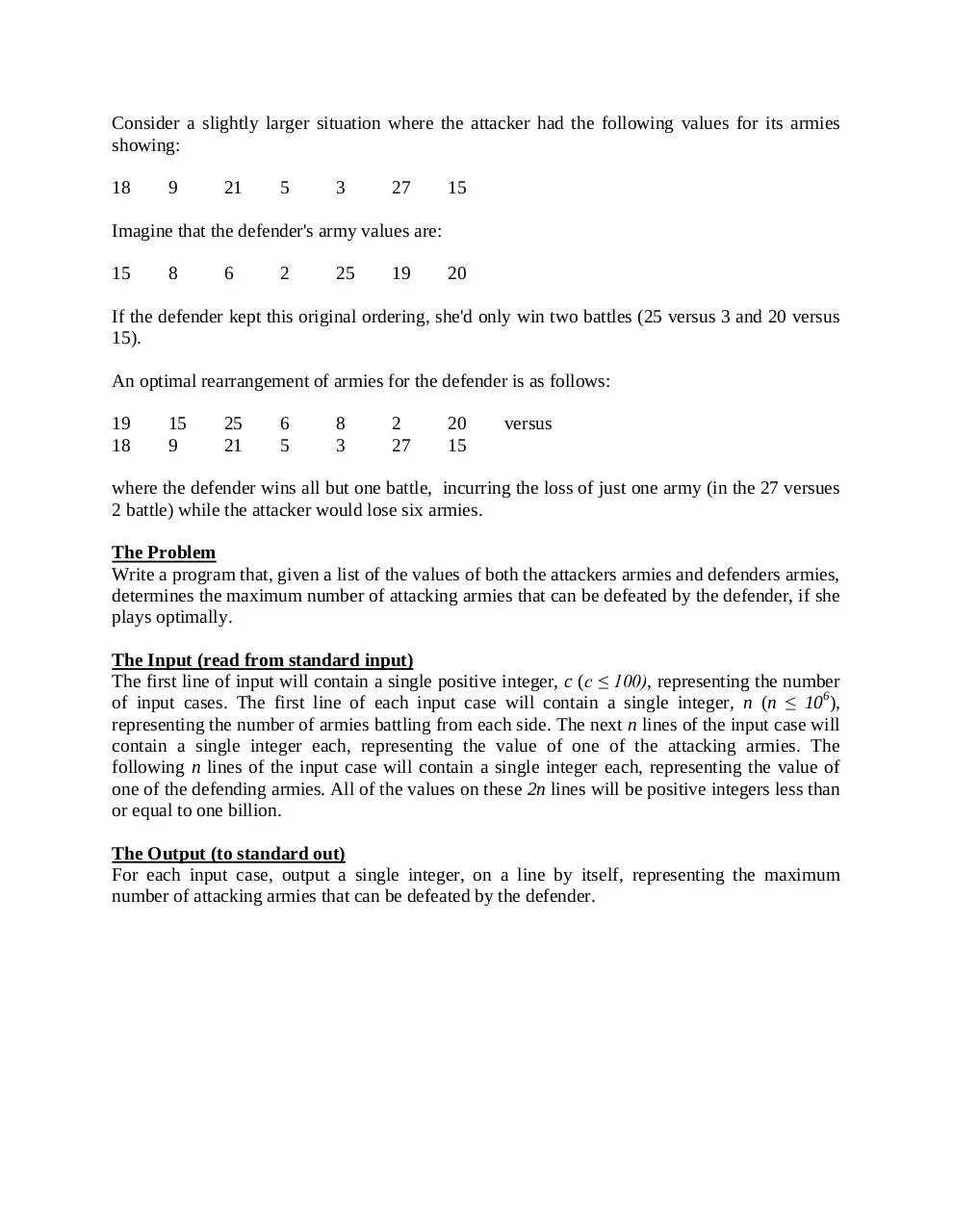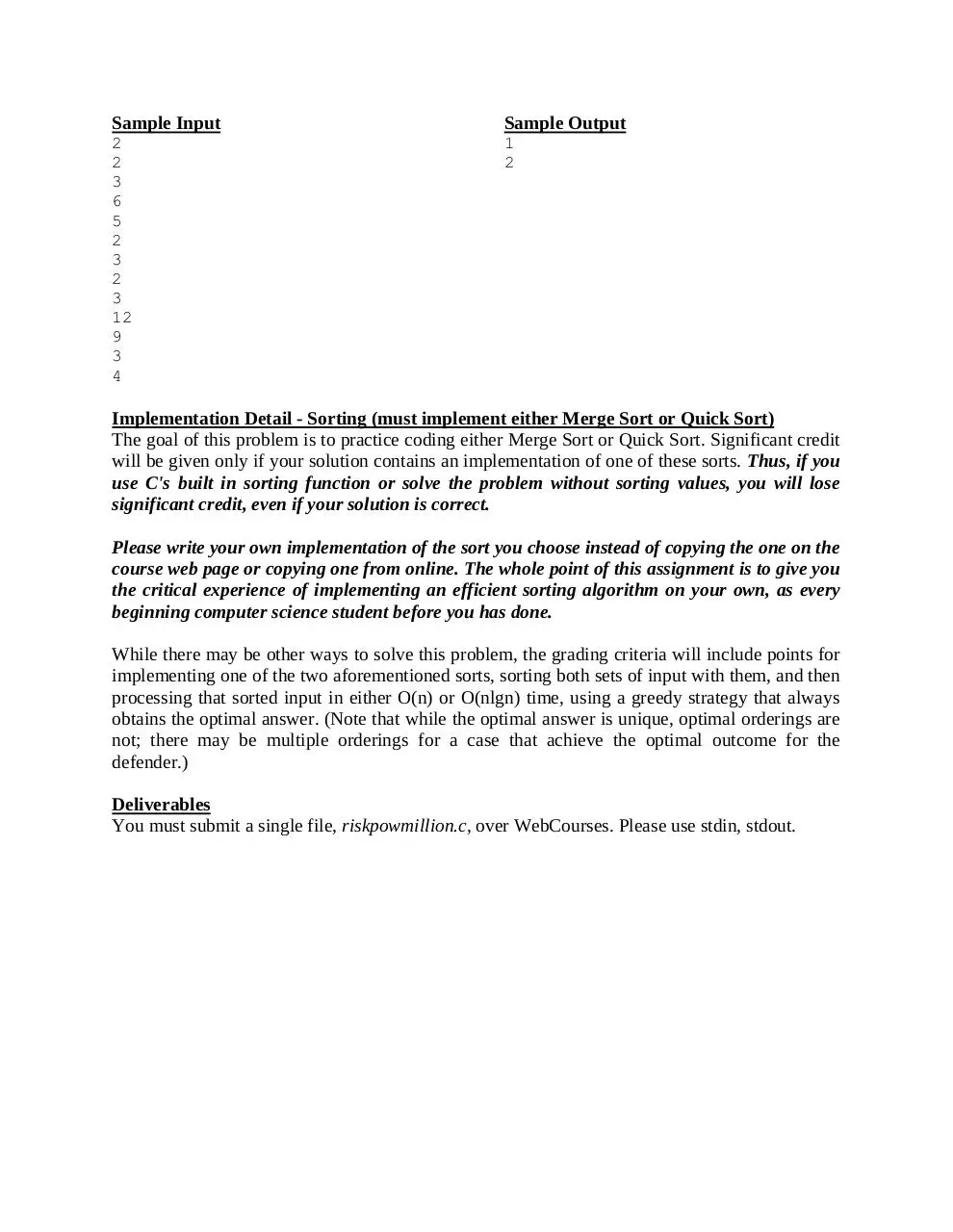4.Risk (PDF)
File information
Author: Guha Arup
This PDF 1.5 document has been generated by Microsoft® Word 2010, and has been sent on pdf-archive.com on 22/02/2016 at 06:37, from IP address 76.29.x.x.
The current document download page has been viewed 517 times.
File size: 170.29 KB (3 pages).
Privacy: public file



File preview
2015 Fall Computer Science I Program #5: Risk1000000
Please Consult WebCourses for the due date/time
In the board game Risk, a group of armies will attack from one country to another. To simulate
the battle, both teams roll dice. The number of dice vary from attack to attack. To "score" the
battle, you match the highest roll of the attacker with the highest roll of the defender. If the
attacker's roll is greater than the defender's roll, then the defender loses an army. Otherwise, the
attacker loses an army. The comparisons continue, between the attacker's second highest roll and
the defender's second highest roll.
Recently, a new game, Risk1000000, similar to Risk, has been released that allows for megabattles
of up to 1,000,000 armies versus 1,000,000 armies. Also, rather than simulating a battle with a
die roll, an army's strength can be any number from 1 to a billion (instead of 1 through 6 for a die
roll). One final difference in Risk1000000 is that it gives the defenders an extra advantage. Instead
of lining up the highest attacking die with the highest defending die and so forth, the attacker
must position his armies for each battle and show this information to the defender. The defender
can then choose any ordering of her armies.
To see the difference, let's consider an example from regular Risk and a couple examples from
Risk1000000. In the original game Risk, if an attacker with two armies rolls a 6 and 3, while a
defender rolls a 5 and a 2, we must match the two maximum rolls (6 versus 5) and the two
minimum rolls (3 verses 2), which results in the defender losing two armies.
If we were to have the same situation in Risk1000000, the defender would see that the attacker has
6 for its first army and 3 for his second army. The defender can then strategically place the 2 for
her first army and the 5 for her second army, resulting in the loss of one defending army and one
attacking army.
Consider a slightly larger situation where the attacker had the following values for its armies
showing:
18
9
21
5
3
27
15
Imagine that the defender's army values are:
15
8
6
2
25
19
20
If the defender kept this original ordering, she'd only win two battles (25 versus 3 and 20 versus
15).
An optimal rearrangement of armies for the defender is as follows:
19
18
15
9
25
21
6
5
8
3
2
27
20
15
versus
where the defender wins all but one battle, incurring the loss of just one army (in the 27 versues
2 battle) while the attacker would lose six armies.
The Problem
Write a program that, given a list of the values of both the attackers armies and defenders armies,
determines the maximum number of attacking armies that can be defeated by the defender, if she
plays optimally.
The Input (read from standard input)
The first line of input will contain a single positive integer, c (c ≤ 100), representing the number
of input cases. The first line of each input case will contain a single integer, n (n ≤ 106),
representing the number of armies battling from each side. The next n lines of the input case will
contain a single integer each, representing the value of one of the attacking armies. The
following n lines of the input case will contain a single integer each, representing the value of
one of the defending armies. All of the values on these 2n lines will be positive integers less than
or equal to one billion.
The Output (to standard out)
For each input case, output a single integer, on a line by itself, representing the maximum
number of attacking armies that can be defeated by the defender.
Sample Input
Sample Output
2
2
3
6
5
2
3
2
3
12
9
3
4
1
2
Implementation Detail - Sorting (must implement either Merge Sort or Quick Sort)
The goal of this problem is to practice coding either Merge Sort or Quick Sort. Significant credit
will be given only if your solution contains an implementation of one of these sorts. Thus, if you
use C's built in sorting function or solve the problem without sorting values, you will lose
significant credit, even if your solution is correct.
Please write your own implementation of the sort you choose instead of copying the one on the
course web page or copying one from online. The whole point of this assignment is to give you
the critical experience of implementing an efficient sorting algorithm on your own, as every
beginning computer science student before you has done.
While there may be other ways to solve this problem, the grading criteria will include points for
implementing one of the two aforementioned sorts, sorting both sets of input with them, and then
processing that sorted input in either O(n) or O(nlgn) time, using a greedy strategy that always
obtains the optimal answer. (Note that while the optimal answer is unique, optimal orderings are
not; there may be multiple orderings for a case that achieve the optimal outcome for the
defender.)
Deliverables
You must submit a single file, riskpowmillion.c, over WebCourses. Please use stdin, stdout.
Download 4.Risk
4.Risk.pdf (PDF, 170.29 KB)
Download PDF
Share this file on social networks
Link to this page
Permanent link
Use the permanent link to the download page to share your document on Facebook, Twitter, LinkedIn, or directly with a contact by e-Mail, Messenger, Whatsapp, Line..
Short link
Use the short link to share your document on Twitter or by text message (SMS)
HTML Code
Copy the following HTML code to share your document on a Website or Blog
QR Code to this page

This file has been shared publicly by a user of PDF Archive.
Document ID: 0000342126.